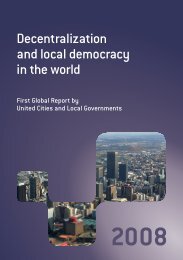Making Cities Resilient Report 2012
Making Cities Resilient Report 2012
Making Cities Resilient Report 2012
You also want an ePaper? Increase the reach of your titles
YUMPU automatically turns print PDFs into web optimized ePapers that Google loves.
CHAPTER 4 | What are local governments doing to build resilience<br />
(new airport and road networks) and 10,076 households. San Francisco, Cebu reports on the removal and<br />
transfer of communities and structures in areas prone to storm surge (10). Makati City’s flood mitigation<br />
programme included relocation of informal settlements along waterways and in landslide-prone areas 13 .<br />
A growing number of cities is engaging in relocation programmes to reduce disaster risk, but much more<br />
needs to be done to understand when this is needed and how it should be implemented. Relocation<br />
programme often impoverish those moved. For many low-income groups living on an at-risk site, the<br />
risks they face from relocation, including disruption to their livelihoods and social networks, may cancel<br />
out any benefits from moving to a safer location. Government relocation is often to sites not compatible<br />
with income-earning opportunities. Delays are often incurred in developing these sites with needed<br />
infrastructure and services. Unfortunately, city governments often give too little consideration to how<br />
settlement upgrading can reduce disaster risk and do away with the need for relocation. In Quito, only if an<br />
informal settlement is declared high risk and the city is unable to undertake risk reduction measures are<br />
resettlement programmes provided. (35)<br />
7. Training, Education and Public<br />
Awareness<br />
Essential 7: Ensure education programmes and training on disaster risk reduction are in place in schools<br />
and local communities.<br />
Many cities include awareness raising as part of their disaster risk reduction strategies (i.e. enhancing<br />
disaster preparedness). This helps to ensure that individuals know what to do in an emergency situation<br />
and what measures they can individually and collectively take in advance to reduce risk to themselves,<br />
their families and their communities. Raising awareness includes formal training schemes and campaigns<br />
that target either a mass or specific audience. They may include simulation exercises and drills to reinforce<br />
messages. Some risk reduction messages (particularly those targeting the youth) can be delivered as<br />
part of broader environmental, arts, or personal development programmes. The academic sector is also<br />
implementing programmes in risk reduction and crisis management.<br />
Community risk training programmes<br />
Many cities have held first responder training to enable communities to respond quickly to a hazard event.<br />
In Quezon City, public training includes rapid response and flood/water rescue, training on collapsed<br />
structures and basic life support. Training is held in schools, hospitals, shopping malls, hotels and<br />
community centres, and involves both the public and private sectors (29). Community training has been<br />
offered in Albay Province on household and community preparedness and for first responders (5). Several<br />
cities prioritised training for community leaders and volunteers, particularly those who are members of<br />
city or community-level disaster management committees or response teams, thus contributing to an<br />
effective decentralised disaster response. Members of Makati’s Barangay Disaster Coordinating Councils<br />
have received training in disaster and emergency management and mass casualty management (31).<br />
Trainings in schools<br />
<strong>Cities</strong> have also prioritised training in schools and colleges, usually on personal safety and emergency<br />
procedures. For example in Bhubaneswar, 3,000 students from 35 schools and 600 college students have<br />
been trained in disaster management planning and safety tips (32). Local governments in Ecuador (as<br />
13. Informal settlers have been given free housing and livelihood opportunities in partnership with Gawad Kalinga (GK), an NGO. The Makati city<br />
government acquired the land necessary for the resettlement.<br />
<strong>Making</strong> <strong>Cities</strong> <strong>Resilient</strong> <strong>Report</strong> <strong>2012</strong> | 55

















